

Ariann Hess-Headlee
Curation: Ancient Egypt. Farming in Ancient Egypt. Ploughing with a yoke of horned cattle in ancient Egypt.
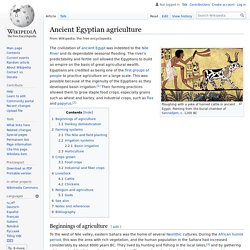
Painting from the burial chamber of Sennedjem, c. 1200 BC The civilization of ancient Egypt was indebted to the Nile River and its dependable seasonal flooding. The river's predictability and the fertile soil allowed the Egyptians to build an empire on the basis of great agricultural wealth. Egyptians are credited as being one of the first groups of people to practice agriculture on a large scale. This was possible because of the ingenuity of the Egyptians as they developed basin irrigation.[1] Their farming practices allowed them to grow staple food crops, especially grains such as wheat and barley, and industrial crops, such as flax and papyrus.[2] Farming systems[edit] The Nile and field planting[edit] Ancient Egyptian mummies unearthed after more than 2,600 years. SAQQARA, Egypt — More than 2,600 years since they were buried, archaeologists in Egypt said Saturday they had found at least 59 ancient coffins in a vast necropolis south of the country's capital Cairo, one containing the pristine mummy of an ancient priest.

The ornate sarcophagi have remained unopened since they were entombed near the famed Step Pyramid of Djoser in Saqqara, according to Egypt's Ministry of Tourism and Antiquities. Footage shared by the ministry showed colorful sarcophagi decorated with ancient Egyptian hieroglyphics. Other artifacts and at least 28 statues were found in the two deep wells, the ministry said. A sealed door was also unearthed where it is expected more mummies may lie behind, said Khaled el-Anany the first Minister of Antiquities and Tourism, adding that the artifacts were in an excellent state of preservation and would be displayed in the Grand Egyptian museum next year. Ancient Egypt: Civilization, Empire & Culture. Under Ahmose I, the first king of the 18th dynasty, Egypt was once again reunited.

During the 18th dynasty, Egypt restored its control over Nubia and began military campaigns in Palestine, clashing with other powers in the area such as the Mitannians and the Hittites. The country went on to establish the world’s first great empire, stretching from Nubia to the Euphrates River in Asia. In addition to powerful kings such as Amenhotep I (1546-1526 B.C.), Thutmose I (1525-1512 B.C.) and Amenhotep III (1417-1379 B.C.), the New Kingdom was notable for the role of royal women such as Queen Hatshepsut (1503-1482 B.C.), who began ruling as a regent for her young stepson (he later became Thutmose III, Egypt’s greatest military hero), but rose to wield all the powers of a pharaoh. Planet Egypt: Birth of an Empire (S1, E1) Ancient Egypt - Egypt's Unexplained Files: Secrets of the Tomb Raiders - Full documentary 2020. Sphinx, mystery in stone - Ancient Egypt - Documentary 2020.
10 facts about Ancient Egypt! Country fact file: Egypt todayIncredible ancient monuments, scorching deserts and bustling cities – this ancient country is now a sprawling, modern landscape!
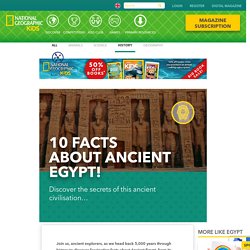
Read on to learn about the Egypt of today… Egyptian flag OFFICIAL NAME: Arab Republic of EgyptFORM OF GOVERNMENT: RepublicCAPITAL: CairoPOPULATION: 87, 562, 261OFFICIAL LANGUAGE: ArabicMONEY: Egyptian pound, guinayAREA: 1,001,449 square kilometresMAJOR MOUNTAIN RANGES: Eastern HighlandsMAJOR RIVER: NileFLAG: Map of Egypt Egypt: geography and landscape Without the Nile River, all of Egypt would be desert.
Only about an 2.5cm of rain falls throughout Egypt each year. Ancient Egypt. Landmarks of Ancient Egypt A typical Naqada II jar decorated with gazelles.
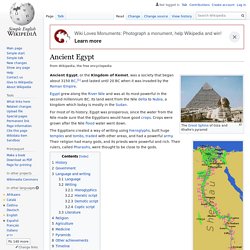
(Predynastic period) Ancient Egypt, or the Kingdom of Kemet, was a society that began about 3150 BC,[1] and lasted until 20 BC when it was invaded by the Roman Empire. Egypt grew along the River Nile and was at its most powerful in the second millennium BC. Its land went from the Nile delta to Nubia, a kingdom which today is mostly in the Sudan. For most of its history, Egypt was prosperous, since the water from the Nile made sure that the Egyptians would have good crops. The Egyptians created a way of writing using hieroglyphs, built huge temples and tombs, traded with other areas, and had a powerful army. History[change | change source] Archaeologists, who study objects left by ancient people, have found that people have lived along the Nile for a very long time. This period in Egyptian history is called predynastic, as it happened before the large dynastic kingdoms were formed.
Government[change | change source] History: Egyptians. Ancient Egyptian History for Kids - Fun Facts to Learn. Ancient Egyptian Baths Most people that lived in Ancient Egypt thought that staying clean was very important and they would use baths to make sure Read More Ancient Egyptian Boats and Transportation Ancient Egypt was a place that was known for the Nile River and this river was important for the daily life of the Egyptians.
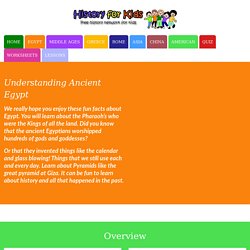
Ancient Egypt For Kids. Egyptian boats Egyptian boats.
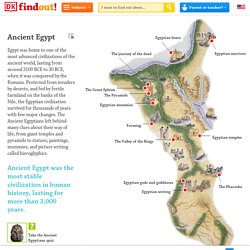
Egyptian Art (article) Ancient Egypt: Crash Course World History #4. National Geographic Society.